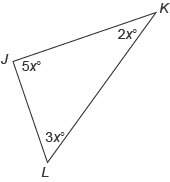
Mathematics, 11.02.2020 21:47 elkinsmarie88oyzd23
Salman Rashid filed a discrimination suit with the EEOC about his organization not allowing him to engage in his customary Friday afternoon prayer sessions at a secluded spot in his workplace. After a round of negotiations between him and the company with the EEOC acting as a mediator, no solution was reached. What will be the step that immediately succeeds the unsuccessful mediation process?
a.
The EEOC will present the employer with the various options to remedy the situation and suggest a future course of action.
b.
The EEOC will initiate an investigation into this instance of religious discrimination at the workplace.
c.
The EEOC will file a lawsuit against the noncompliant organization.
d.
The EEOC will re-file the complaint to start the process afresh
e.
The EEOC will notify the organization of the charges made by Salman

Answers: 3


Other questions on the subject: Mathematics

Mathematics, 21.06.2019 16:50, Jfhehwnxodin8398
Consider circle h with a 3 centimeter radius. if the length of minor arc what is the measure of zrst?
Answers: 2


Mathematics, 21.06.2019 21:30, happysage12
Every weekday, mr. jones bikes from his home to his job. sometimes he rides along two roads, the long route that is shown by the solid lines. other times, he takes the shortcut shown by the dashed line. how many fewer kilometers does mr. jones bike when he takes the shortcut instead of the long route?
Answers: 1

Mathematics, 21.06.2019 21:30, gonzalezashley152
In a test for esp (extrasensory perception), the experimenter looks at cards that are hidden from the subject. each card contains either a star, a circle, a wave, a cross or a square.(five shapes) as the experimenter looks at each of 20 cards in turn, the subject names the shape on the card. when the esp study described above discovers a subject whose performance appears to be better than guessing, the study continues at greater length. the experimenter looks at many cards bearing one of five shapes (star, square, circle, wave, and cross) in an order determined by random numbers. the subject cannot see the experimenter as he looks at each card in turn, in order to avoid any possible nonverbal clues. the answers of a subject who does not have esp should be independent observations, each with probability 1/5 of success. we record 1000 attempts. which of the following assumptions must be met in order to solve this problem? it's reasonable to assume normality 0.8(1000), 0.2(1000)%30 approximately normal 0.8(1000), 0.2(1000)% 10 approximately normal srs it is reasonable to assume the total number of cards is over 10,000 it is reasonable to assume the total number of cards is over 1000
Answers: 1
You know the right answer?
Salman Rashid filed a discrimination suit with the EEOC about his organization not allowing him to e...
Questions in other subjects:



English, 24.08.2019 04:10

Mathematics, 24.08.2019 04:10


Mathematics, 24.08.2019 04:10

Mathematics, 24.08.2019 04:10

Physics, 24.08.2019 04:10





